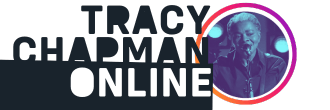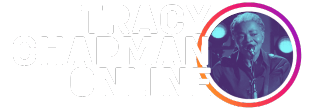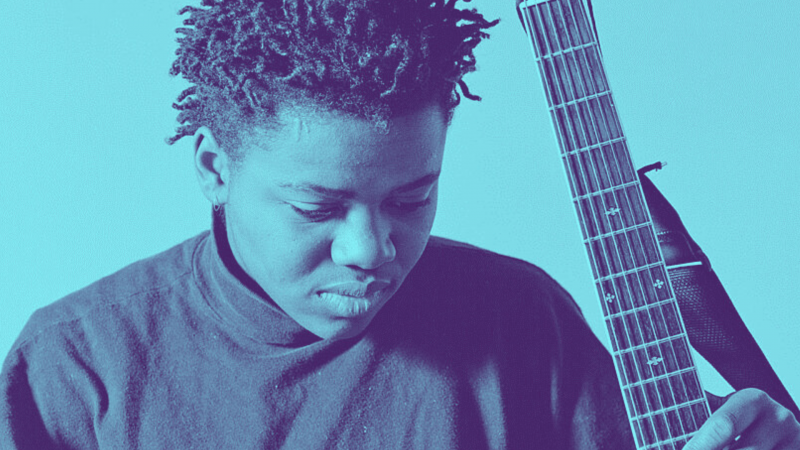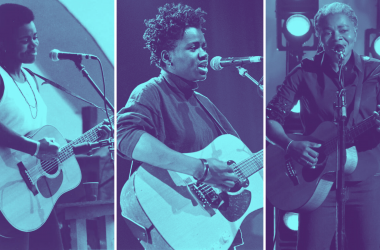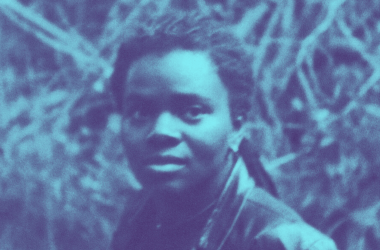In an era when the label folksinger-songwriter does little to guarantee success, Tracy Chapman has seen her dreams come true. When Chapman takes the stage sporting short dreadlocks, blue jeans, and a turtleneck sweater, accompanied only by her acoustic guitar, listeners lean forward to hear her husky contralto pour forth poignant reflections on contemporary urban life. As Steve Pond of Rolling Stone noted, Chapman’s voice “is the sound of a smart black woman growing up in the city with her eyes wide open.”
Though she is a relative newcomer to the folk music circuit, Chapman has always made music an important part of her life. Chapman’s parents divorced when she was four years old, and she grew up with her mother and older sister in a largely black middle-class neighborhood in Cleveland, Ohio. At an early age she learned to sing, play the clarinet and organ, and compose simple songs that she sang with her sister, Aneta. While still in grade school Chapman began to teach herself how to play the guitar. She told Washington Post writer Richard Harrington
Wanting to make a better life for herself than those she witnessed about her, Chapman worked hard to earn A Better Chance (ABC) minority placement scholarship to the Wooster School, a small, progressive, private high school in Danbury, Connecticut. In contrast to the metal-detector-equipped public high school she had attended, at Wooster she was thoroughly immersed in an atmosphere of social and political discussion. At times she had difficulties with her sheltered classmates; she told Time that “students there just said very stupid things. They had never met a poor person before. In some ways they were curious, but in ways that were just insulting.” The school was a haven for musicians, however. She met other guitar players who introduced her to a variety of popular music, including the early protest works of Bob Dylan. Chapman’s teachers recognized her talent and gave her ample opportunities to perform. In a gesture of support, the school chaplain took up a collection among the faculty and students and bought the young singer a new guitar to replace her battered one.
Despite the strong support for her musical talent, Chapman did not seriously consider music as a career. When she enrolled at Tufts University, near Boston, she aspired to become a veterinarian. However, a short while later she changed her major to anthropology with an emphasis on West African cultures, the field in which she eventually earned her bachelor’s degree. In college Chapman continued to perform her own compositions in coffee houses, on street corners, and at folk-oriented church services. She was offered a recording contract with an independent label but turned it down, not wanting to interrupt her education. Chapman’s decision proved to be fortuitous. One of her classmates, Brian Koppelman, approached her after hearing her play to suggest that his father might be able to help her singing career. The father in question was Charles Koppelman, the K in SBK, one of the world’s largest music publishing companies. At Brian’s suggestion, Charles Koppelman came to hear Chapman perform, and later he told Newsweek: “Her songs were wonderful melodies with important lyrics. That was enough. But when I saw her in front of an audience! When she smiled, everyone smiled. When she was serious, you could hear a pin drop.”
Chapman had considered working toward a master’s degree in ethnomusicology, the study of chiefly non-European music, especially in relation to the culture that produces it. But after graduating in 1986, she signed a management agreement with SBK, to be represented by Elliott Roberts, who also manages singers Joni Mitchell and Neil Young. A demonstration cassette taped by Chapman at the SBK studios eventually led to a recording contract with Elektra Records.
Chapman settled on producer David Kershenbaum and hired a backup band to contribute to the record for Elektra. Describing Chapman’s voice to Time, Kershenbaum said, “The timbre of it is rare to find. It instantly disarms you.” Because she is a prolific songwriter, there was no lack of music from which to select the pieces that make up her self-titled debut album. Tracy Chapman breaks all of the rules of popular music marketing. The melodies wander and are oddly phrased, and many of the songs explore serious subjects: racism, domestic violence, the failed American dream, material and emotional self-determination and do not fit the format of commercial radio. The background instrumentais are limited, focusing attention on Chapman’s percussive use of the acoustic guitar, and one selection is even sung a cappella. In seeming defiance to trends, Chapman’s album rose to the number one position on Billboard’s best-seller chart without discernible airplay and engendered a music video, which alternates segments of Chapman singing in her usual concert attire and still photographs of gritty real-life scenes.
For just this sort of blunt realism, reviewers describe Tracy Chapman as downbeat, particularly the cuts “Talkin’ ’bout a Revolution” and “Why?” Yet Chapman remains hopeful that her music can reach a wide audience and deliver a message. As she told the New York Times: “On a certain level, I think something positive is going to happen, though I don’t think it’s necessarily going to be an actual revolution. Even though I’m a cynic, there’s still a part of me that believes people will get to a certain point where they can’t stand the way things are and have to change the way they think.”
The power of Chapman’s songs to motivate change lies in their psychological realism, their universal poignancy. With an eye for detail, Chapman uses just enough specifics to suggest events or situations known to listeners regardless of where they live. She chronicles in song the human condition. When asked about her songwriting ability, Chapman told Musician writer Kristine McKenna:
Chapman has frequently been compared to folksingers Joan Armatrading, Joni Mitchell, and Phoebe Snow. Some reviewers see her as “a bridge between the folk music revival of the eighties and the socially conscious folk movement of the sixties,” a bridge girded by the efforts of another female folk singer, Suzanne Vega. Chapman balks at being labeled, whether the label is folksinger or black woman artist. As she told a Chicago Tribune writer:
Chapman’s performance schedule has no doubt been influenced by her social conscience: the Sisterfire festival in Washington, D.C.; Amnesty International’s world-wide Human Rights Now! tour; and a march to commemorate Dr. Martin Luther King. Chapman takes to the stage with more ease than she wears her star status, however. Even as a young dreamer, Chapman never expected to sign with a major label, and when she did, she didn’t foresee the popularity of Tracy Chapman, albums and person.
Her second record, Crossroads, was tremendously popular, selling 4 million copies in the first five months of its release. Because of her repeat success many critics believe that a resurgence in protest music is likely in the 1990s, thanks in part to Chapman. Not altogether comfortable with her celebrity, she admitted to McKenna, of Musician:
For the Record
Born 1964, in Cleveland, Ohio. Education: Tufts University, B.A. in anthropology, 1986.
Played ukelele, organ, and clarinet as a young child; began playing guitar and singing original songs at the age of ten; during high school, performed at school functions and at local coffee houses in Connecticut; while in college, performed at church services, on street comers, and in coffee houses in Boston, Mass.; signed a recording contract, 1986; live performer at clubs, festivals, and in U.S. and international concerts, 1986
Awards: Grammy Award for best new artist, for best female pop vocal performance, and for best contemporary folk performance, all 1989.
Selected discography
- Tracy Chapman (includes “Fast Car,” “Baby Can I Hold You,” “Talkin’Bout a Revolution,” “She’s Got Her Ticket, ” “Behind the Wall,” “For My Lover,” “If Not Now…,” “Why?” “Across the Lines,” “Mountains o’ Things,” and “For You”), Elektra, 1988.
- Crossroads, Elektra, 1989.
Sources
- Chicago Tribune, August 14, 1988.
- Detroit News, September 4, 1988.
- Musician, June 1988.
- Newsweek, June 20, 1988.
- New York Times, September 4, 1988.
- Rolling Stone, June 2, 1988; June 30, 1988.
- Time, August 15, 1988; March 12, 1990.
Source: By Jeanne M. Lesinski Contemporary Musicians, Vol 55 © 1989 Gale Cengage.
